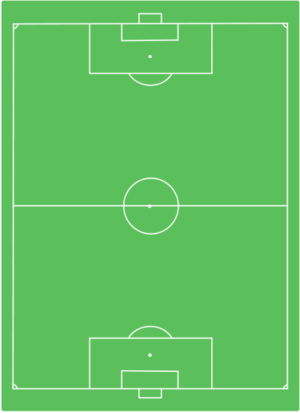Malmö FF
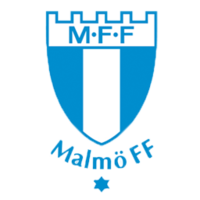 |
|||
| Full name | Malmö Fotbollsförening | ||
|---|---|---|---|
| Nickname(s) | Di blåe (The Blues) Himmelsblått (Sky Blue) |
||
| Founded | 1910 | ||
| Ground | Swedbank Stadion, Malmö (Capacity: 24,000 (21,000 seated)) |
||
| Chairman | |||
| Manager | |||
| League | Allsvenskan | ||
| 2009 | Allsvenskan, 7th | ||
|
|||
Malmö Fotbollsförening, also known simply as Malmö FF, is a professional football club based in Malmö, Scania, Sweden. The club, formed on 24 February 1910, has been awarded 15 national championship titles (despite winning the Swedish football league 18 times) and 14 national cup titles, making them one of the most successful clubs in Sweden.[1] Malmö FF was the runner-up in the 1979 European Champions Cup final, which they lost 1-0 to Nottingham Forest, the club was the first and as of 2010 still the only Swedish football club to have reached the final of the competition. For this, MFF were awarded the Svenska Dagbladet Gold Medal, as of 2010 the only club to have been so.[2]
Malmö FF are currently playing in the highest Swedish league, Allsvenskan, where they have played the majority of the seasons during their existence. The club was most successful during the 1970s when they won five Swedish championships and four Swedish cup titles. The club first won Allsvenskan in 1944 and took their latest title in 2004.[3]
Contents |
History
Early years
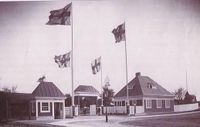
Malmö Fotbollsförening was founded at Malmö IP on February 24, 1910 by 19 young men. However the history of the club dates back to 1905 when a municipal initiative to let the city youth play organized football was formed. One of the youth teams, which were named Bollklubben Idrott was the predecessor to what was going to become Malmö FF. BK Idrott joined the newly created football department of IFK Malmö in 1909 but soon left due to issues between the two clubs. In 1910 the members of BK Idrott founded Malmö FF; the first chairman was Werner Mårtensson.[4]
The first ten years of the clubs history were spent in local and regional divisions, the majority of the matches were played in the city division called Malmömästerskapen but the club also competed in regional competitions in Scania as well as various matches against Danish clubs. 1916 proved to be a successful year for Malmö FF as they reached the final of Scanian regional competitions called Distrikmästerskapen for the first time. The final was played against rival Helsingborgs IF, the game was lost by 3-4. The club also defeated local rival IFK Malmö three times during the season and thus earned the unofficial but much desired title as Malmös best football club.
In 1920 Swedish football clubs were invited by the Swedish Football Association to compete in official national competitions. The club earned a place in Division 2 Sydsvenska Serien which they won the first year to be promoted to Svenska Serien Västra, the highest tier in Sweden at the time, however the club was relegated the next year and found themselves playing in Sydsvenska Serien until they finally achieved promotion to the highest tier in Swedish football, Allsvenskan, in 1931.
First years in Allsvenskan and early glory
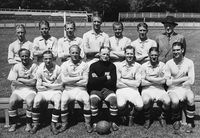
Two seasons with respectable league positions were played until the club was relegated as a penalty of breaking amateur regulations in 1934. The club had paid their players a small sum of money for each game, something which was against the rules at the time but which was common to do by many clubs; however Malmö FF were the only club to show this in the accounting records. This resulted in relegation to Division 2 again as well as bans for the entire board and 26 players. The unofficial version of the events tells the story that it was in fact local rival IFK Malmö who reported this to the Swedish Football Association, Many of Malmö FF fans, especially among the older ones, still think of IFK Malmö's way of acting as an act of treason.[5]
The club made their way back to Allsvenskan in 1937 after two seasons in Division 2. In the same year legendary chairman Eric Persson was elected after being secretary since 1929, he would go on to serve as chairman until 1974. After two years of positions in the lower part of the league 1939 was a very successful as the club reached their highest position yet, third place in Allsvenskan, 9 points after champions IF Elfsborg. Many started to believe that the clubs first Swedish Championship was close but it would take until 1944 when the club could claim their first victory in Allsvenskan after 2-1 in the next to last game against AIK in front of 36,000 spectators at Råsunda. The last game of the season was won against Halmstad BK with 7-0.
In the next 9 years Malmö FF finished in the top 3 every season. This resulted in four Swedish Championships in 1949, 1950, 1951 and 1953 as well as finishing as runners-up three times in 1946, 1948 and 1952. It should also be mentioned that the club won Svenska Cupen in 1944, 1946, 1947, 1951 and 1953 as well as finishing as runners-up in 1945. Malmö FFs peak during the late 1940s and early 1950s is once again illustrated by the streak of 49 matches between May 6, 1949 and June 1, 1951, in which the team went unbeaten, 23 of these were an unbroken streak of victories.
The club would finish as runners-up in Allsvenskan two more times in 1956 and 1957 before leaving Malmö IP for newly built Malmö Stadion in 1958. The stadium, which was built for the 1958 FIFA World Cup would be the home for the club for the next 50 years. The club started the 1960’s with a young team and achieved fairly good league positions. In 1964 Malmö FF contracted Spanish manager Antonio Durán; this was the first step of many that lead to the most successful era in the history of the club. Young talents such as Lars Granström and Bo Larsson emerged during the early 1960’s and would also prove to be crucial pieces in the success that would come in the 1970s. The club finished second in 1964 but would go on to win its 6th Swedish Championship in 1965 when Bo Larsson scored an incredible 28 goals to win the goal scorer league. Malmö FF once again won Allsvenskan in 1967 after a less successful year in 1966. Many of the clubs young talents as well as talents bought in from neighbouring clubs in Scania in 1967 started to become a team that constantly finished in the top 3 in Allsvenskan.[6]

Successful 1970s, European Cup 1979 and the 1980s
After finishing as runners-up for the last two years of the 1960s Malmö FF started the most successful decade of the clubs history with a Swedish Championship in 1970. In the 1970s the club won Allsvenskan in 1970, 1971, 1974, 1975 and 1977 as well as Svenska Cupen in 1976 and 1978. However the most glorious year of the 1970s for Malmö FF was 1979. The club had qualified for the 1978–79 European Cup by winning Allsvenskan 1977, after victories against AS Monaco, Dynamo Kiev, Wisla Krakow and Austria Wien, the club reached the final of the competition. The final was played at Olympiastadion in Munich, West Germany against Nottingham Forest. Trevor Francis scored the only goal of the match winning it 1-0 for Nottingham. Nevertheless the 1979 final is the biggest moment in the history of Malmö FF.
Much of the success during the 1970s were due to new tactics and training methods brought to the club by English manager Bob Houghton who managed the club between 1974 and 1980. Chairman Eric Persson was succeeded in 1974 by Hans Cavalli-Björkman. After a period of respectable positions in the league under the management of Keith Blunt and Tord Grip in the early 1980s Roy Hodgson took over as manager in 1985. He led the club to two Swedish Championships in 1986 and 1988 even though the club won Allsvenskan five years in a row between 1985 and 1989. This was due to the competition format at the time; between 1982 and 1992 Allsvenskan had play-offs for the best teams after the ordinary season was over. The club reached the play-off final for four years in a row between 1986 and 1989 but only managed to win the final in 1986 and 1988. Nevertheless the 1980s are regarded as very successful period for Malmö FF. Apart from Allsvenskan the club won Svenska Cupen in 1984, 1986 and 1989.[7]
Apart from finishing as runners-up in Allsvenskan in 1996 the 1990s was a decade of disappointment as the club failed to win Allsvenskan and Svenska Cupen throughout the entire decade. The decade ended symbolically with relegation from Allsvenskan in 1999 and the darkest moment in the history of the club was a fact. Hans Cavalli-Björkman was succeeded as chairman by Bengt Madsen in 1999 and former player Hasse Borg was contracted as Director of Sport. These operational changes as well as the emergence of young talent Zlatan Ibrahimovic lead to the return to Allsvenskan in 2001. Zlatan Ibrahimović rose to fame and became an important player in the clubs campaign to return to the top league. Ibrahimović was later sold to Ajax in 2001, before playing for Juventus, Internazionale, and eventually FC Barcelona in 2009.
Malmö FF have in many ways reflected the multi-cultural nature of Malmö. In 1990, defender Jean-Paul Vondenburg became the first black player playing for the Swedish national football team, playing against the United Arab Emirates. In 1998, midfielder/striker Yksel Osmanovski became the first Muslim player for Sweden, when Sweden lost 1-0 to USA.
Latest Championship in 2004 to the present
The return to Allsvenskan was the start of the successful early 2000’s when the club finished top 3 for three in a row and winning Allsvenskan in 2004, the clubs 15th Swedish Championship. Tom Prahl was the manager during these successful years. In 2005 the club was one match away from qualifying for the UEFA Champions League but lost surprisingly against FC Thun. The result during the next years of the decade would go on to disappoint the fans of the team as many expected a club such as Malmö FF to finish at the top of the table. Successful sponsor work and player sales had also made the club the richest club in Sweden at the time.[8]
In 2009 the club moved from Malmö Stadion to Swedbank Stadion, a stadium built entirely for football and located just beside the old one. At the end of the decade chairman Bengt Madsen announced that he would step down as chairman and was replaced by Håkan Jeppsson in 2010.
The club is one of the dominating football clubs in Sweden, as of the 2009 season the club ranks second in overall Allsvenskan table maratontabellen.[9] On the day of the clubs 100th anniversary in 2010, the Swedish football magazine Offside determined that Malmö FF is the greatest football club in Swedish history.[10]
Colours and crest
|
|
| 1920- |
|
|
| 1910–1920 |
|
|
| 1910 |
The club is often known by the nicknames Di blåe (The Blue Ones) and Himmelsblått (Sky Blue). The reason for these nicknames are the club colours of light blue and white. The players wear sky blue shirts, white shorts, and sky blue socks. The away colours are red and white striped shirts, black shorts, and black socks.[11]
The club colours have not always been sky blue. The predecessor club BK Idrott wore blue and white striped shirts and white shorts, this kit was used for the first six months of 1910 after Malmö FF had been founded. This was later changed to red and white striped shirts and black shorts to symbolize that Malmö FF was a new club, a very similar kit is now used as the away kit for historic reasons. The present day sky blue kit was introduced in 1920.[12]
The crest of Malmö FF is made up of a shield with two vertical sky blue fields one the sides and one vertical white field in the middle. Underneath the shield is "Malmö FF" spelled out in sky blue letters with a sky blue star underlining the text. In the top area of the shield is a white horizontal field over the three vertical fields. The abbreviation of the club name "MFF" is spelled out with sky blue letters in this field. On top of the shield is five tower like extensions of the white field.[11] The crest made its debut on the shirt in the 1940s.[13]
In modern times a golden star has been added over the shield, this is a feature only used on the crests on player shirts. In the original logo the full club name and sky blue star beneath the shield was not featured. For the 100th anniversary of the club in 2010 the years 1910 and 2010 will be featured on each side of the shield on a sky blue ribbon behind the shield.
Supporters
Malmö FF is well known for having a big and loyal local following, and its fans are widely regarded as some of the most loyal and active in Sweden. Malmö FF has several fan clubs, of which the largest is the official fan club MFF Support. It was founded in 1992. MFF Support describes itself as “an idealistic and non-political association working against violence and racism”.[14] The current Chairman of MFF Support is Ola Solér.
Apart from MFF Support there are several smaller independent supporter groups and formations. The most prominent of these is Supras Malmö which was founded in 2003 by a coalition of smaller ultras groups and devoted fans. The name "Supras" is derived from the words supporters and ultras – the latter indicating that the group is inspired by a fan culture with roots in the Mediterranean. Supras Malmö is the most visible group at the main supporter stand on Swedbank Stadion today, marking its presence with banners, flags and choreographies. Another example of a group with similar goals is Rex Scania. MFF Tifosi 96 is a network of supporters creating tifos for special occasions and important games.
The attendance average for the 2009 season was 14,815, the second best attendance in Allsvenskan 2009 after Swedish champions AIK.[15]
Rivals
The main rivals of the club are Helsingborgs IF, IFK Göteborg and IFK Malmö. The rivalry between Malmö FF and Helsingborgs IF has existed since Malmö FF were promoted up to Allsvenskan in the 1930s, the rivalry is of geographical nature since both teams are from Scania in southern Sweden. The rivalry with IFK Göteborg is of title reasons, the two clubs are the most successful clubs in Swedish football history and the only ones to have appeared in European cup finals, IFK Göteborg in the UEFA Cup in 1982 and 1987 and Malmö FF in the European Cup in 1979.
The rivalry with IFK Malmö is based on geographical reasons since the two clubs come from the same city and used to play at the same stadium back in the early 20th century. There is also further reasons for the rivalry, as in 1933 board members of IFK Malmö revealed to the Swedish Football Association that Malmö FF paid their players, something which at this time was against the rules.[16][17] Due to this, Malmö FF was relegated but did make it back to Allsvenskan as soon as in 1936. However, Malmö FF still consider the act from IFK Malmö as an act of betrayal. IFK Malmö does not play in Allsvenskan any longer, the last time being in 1962, thus matches between the two sides are rare.
Minor rivalry because of geographical status exists with Trelleborgs FF and Landskrona BoIS since they come from Scania as well as Malmö FF, however rivalry with these clubs are far from the level of rivalry with Helsingborg, IFK Göteborg and IFK Malmö.
Stadiums
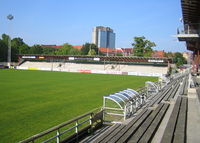
Malmö IP, capacity 7,600
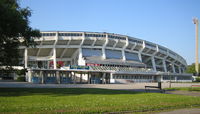
Malmö Stadion, capacity 27,500
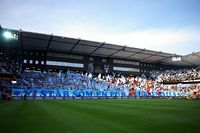
Swedbank Stadion, capacity 24,000
Malmö FF's first stadium was Malmö IP, which was shared with arch-rivals IFK Malmö. The team played here from the founding of the club in 1910 to 1958. The stadium still exists today and is the stadium of ladies team LdB FC Malmö, formally being the ladies section of Malmö FF. Present day capacity is 7,600 but attendance was usually much more at the time when Malmö FF played at the stadium. For the last season in 1957 the attendance average was 15,500.[18] The stadium is still an essential part of the clubs history as it was here that the club was founded, played its first 47 seasons and won five Swedish championships.
A new stadium in Malmö had to be constructed after Sweden was awarded the 1958 FIFA World Cup – this saw the birth of Malmö Stadion. Malmö FF played their first season at the stadium in 1958. The first time the club won the Swedish championship at the stadium was in 1965.[19] An upper tier was added to the stadium in the '80s, and was completed in 1992.[20] The club enjoyed its most successful era in its history at the stadium having won ten out of fifteen Swedish championships at the stadium.
Following the 2004 victory in Allsvenskan, voices were raised for the construction of a new stadium in Malmö. In July 2005, Malmö FF announced that a new stadium was to be constructed – Swedbank Stadion, a 18,000 seatings and 6,000 standings stadium. Construction started in 2007 and was finished in 2009. The stadium is located next to Malmö Stadion. Although there was still small-scale construction going on around the stadium at the time, the stadium was inaugurated on 13 April 2009 with the first home game of the 2009 season against Örgryte IS; Malmö FF's Labinot Harbuzi scored the inaugural goal in the 61st minute.[21]
In popular culture
Malmö FF has been the subject and featured in several films.
The most noteworthy examples are Swedish football documentaries "Blådårar 1" and "Blådårar 2" which is portrayals of the club from both supporter and player perspective during the 1997 and 2000 season. Blådårar 1 is set in 1997 when the club finnished third in Allsvenskan, the focus of the film is on devoted fan Lasse, player Anders Andersson, former chairman Hans Cavalli-Björkman and many others.[22] Blådårar 2 is set in 2000, the year after the club had been relegated to Superettan and follows the team as they fight to make Malmö FF a club in Allsvenskan again.[23] The film continues to follow fan Lasse of the first film but a major part of the film is the focus on Zlatan Ibrahimović, his progress and how he was eventually sold to AFC Ajax during the 2001 season. The two films have become known as classic portrayals of the club.
Malmö FF has been featured in the documentary series "Mitt Hjärtas Malmö", a series of documentaries covering the history of Malmö, clips including match footage from the 1940s (Volume 7) and match footage from the 1979 European Cup Final in Munich through a fan perspective (Volume 8).[24] Volume 9 is entirely about the club because of the 100th anniversary in 2010.[25]
Other examples of films featuring the club is the Swedish 2005 drama movie "Om Sara", actor Alexander Skarsgård plays the football star Kalle Öberg, who plays for MFF.[26] Also, a recurring sketch in the second season of Hipphipp! involves a group of Malmö FF fans singing and chanting while performing every-day tasks, such as shopping or operating an ATM.
Current squad
As of 2010-07-30[27] Note: Flags indicate national team as has been defined under FIFA eligibility rules. Players may hold more than one non-FIFA nationality.
|
|
Out on loan
Note: Flags indicate national team as has been defined under FIFA eligibility rules. Players may hold more than one non-FIFA nationality.
|
For season transfers, see either transfers winter 2009–2010 or transfers summer 2010.
Club hierarchy
|
Technical staff
|
Season results
This is a list of recent season results, for a complete list of season results use the link above
-
Season Pos. Pl. W D L GS GA P Notes 2000 SE 2 30 20 3 7 48 32 60 promoted 2001 AS 9 26 9 5 12 39 46 32 2002 AS 2 26 14 4 8 52 32 46 2003 AS 3 26 14 6 6 50 23 48 2004 AS 1 26 15 7 4 44 21 52 2005 AS 5 26 12 5 9 38 27 41 2006 AS 7 26 10 8 8 43 39 38 2007 AS 9 26 9 7 10 29 28 34 2008 AS 6 30 12 8 10 51 46 44 2009 AS 7 30 11 10 9 40 25 43
Notable players
|
Möller
P.Andersson
Kristensson
R.Andersson
Erlandsson
Larsson
Thern
Schwarz
Prytz
Dahlin
|
| The Sydsvenskan team. |
List Criteria:
- player has been picked as one of the 11 best players in the official Sydsvenskan team, or
- player has made more than 500 appearances for the club, or
- player has had a very close connection to the club, or
- player has won Guldbollen, or
- player has achieved great international fame
Year after player name in parentheses is the year the player started playing for Malmö FF. All players are from Sweden unless otherwise stated.
1930's
- Erik Nilsson (1934) - 600 games, 4 goals
- Helge Bengtsson (1934) - 501 games, 3 goals
1940's
- Egon Jönsson (1943) - 405 games, 269 goals
1950's
- Prawitz Öberg (1952) - 515 games, 103 goals
- Ingvar Svahn (1957) - 414 games, 161 goals
1960's
- Bo Larsson (1962) - 546 games, 289 goals
- Krister Kristensson (1963) - 626 games, 16 goals
- Roy Andersson (1968) - 624 games, 49 goals
- Roland Andersson (1968) - 564 games, 13 goals
1970's
- Jan Möller (1971) - 591 games, 1 goals
- Ingemar Erlandsson (1976) - 473 games, 46 goals
- Magnus Andersson (1977) - 568 games, 28 goals
- Robert Prytz (1977) - 262 games, 57 goals
- Torbjörn Persson (1979) - 574 games, 39 goals
1980's
- Jonnie Fedel (1984) - 588 games, 1 goals
- Jonas Thern (1985) - 160 games, 30 goals
- Martin Dahlin (1987) - 176 games, 83 goals
- Stefan Schwarz (1987) - 103 games, 7 goals
- Patrik Andersson (1989) - 184 games, 24 goals
1990's
- Daniel Andersson (1995) - 366 games, 33 goals
- Hasse Mattisson (1996) - 350 games, 39 goals
- Zlatan Ibrahimović (1999) - 69 games, 16 goals
Notable Managers
This is a list of managers who have won one or more titles at the club
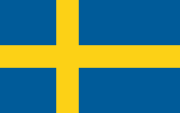 Sven Nilsson (1944, 1945–1947 and 1950) - Allsvenskan 1944, Svenska Cupen 1944, 1946 and 1947
Sven Nilsson (1944, 1945–1947 and 1950) - Allsvenskan 1944, Svenska Cupen 1944, 1946 and 1947 Kálmán Konrád (1947–1950) - Allsvenskan 1949 and 1950,
Kálmán Konrád (1947–1950) - Allsvenskan 1949 and 1950,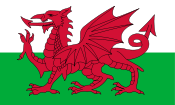 Bert Turner (1951–1955) - Allsvenskan 1951 and 1953, Svenska Cupen 1951 and 1953
Bert Turner (1951–1955) - Allsvenskan 1951 and 1953, Svenska Cupen 1951 and 1953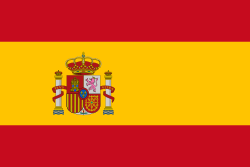 Antonio Durán (1964–1971) - Allsvenskan 1965, 1967, 1970 and 1971, Svenska Cupen 1967
Antonio Durán (1964–1971) - Allsvenskan 1965, 1967, 1970 and 1971, Svenska Cupen 1967 Karl-Erik Hult (1972–1973) - Svenska Cupen 1973
Karl-Erik Hult (1972–1973) - Svenska Cupen 1973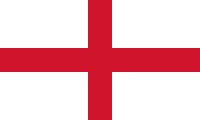 Bob Houghton (1974–1980 and 1990–1992) - Allsvenskan 1974, 1975 and 1977, Svenska Cupen 1974, 1975, 1978 and 1980
Bob Houghton (1974–1980 and 1990–1992) - Allsvenskan 1974, 1975 and 1977, Svenska Cupen 1974, 1975, 1978 and 1980 Tord Grip (1983–1984) - Svenska Cupen 1984
Tord Grip (1983–1984) - Svenska Cupen 1984 Roy Hodgson (1985–1989) - Allsvenskan 1986 and 1988, Svenska Cupen 1986 and 1989
Roy Hodgson (1985–1989) - Allsvenskan 1986 and 1988, Svenska Cupen 1986 and 1989 Tom Prahl (2002–2005) - Allsvenskan 2004
Tom Prahl (2002–2005) - Allsvenskan 2004
Club records
- Record League victory: 12–0 v Halmstad BK, Allsvenskan, 3 June 1943 / v Jönköpings Södra IF, Allsvenskan, 26 May 1949[28]
- Record League defeat: 1–7 v IF Elfsborg, Allsvenskan, 10 April 1926
- Highest attendance (at Malmö Stadion): 29,328 v Helsingborgs IF, 24 September 1967
- Highest attendance (at Swedbank Stadion): 23,347 v Örgryte IS, 13 April 2009
- Highest attendance (at Malmö IP): 22,436 v Helsingborgs IF, 1 June 1956
- Highest attendance average: 20,061; 2004 Season
- Most appearances, total: 625 — Krister Kristensson (1963–1978)
- Most appearances, Allsvenskan: 348 — Krister Kristensson (1963–1978)
- Most goals scored, total: 341 — Hans Håkansson (1927–1938)
- Most goals scored, Allsvenskan: 119 — Bo Larsson (1962–1966, 1969–1979)
- Most goals scored in a season, Lower league: 30 — Hans Håkansson, 1935/36
- Most goals scored in a season, Allsvenskan: 28 — Bo Larsson, 1965
Achievements
- Swedish Champions:
- Winners (15): 1943-44, 1948–1949, 1949–1950, 1950–1951, 1952–1953, 1965, 1967, 1970, 1971, 1974, 1975, 1977, 1986, 1988, 2004
- Allsvenskan:
- Winners (18) (Record): 1943–1944, 1948–1949, 1949–1950, 1950–1951, 1952–1953, 1965, 1967, 1970, 1971, 1974, 1975, 1977, 1985, 1986, 1987, 1988, 1989, 2004
- Runners-up (14): 1945–1946, 1947–1948, 1951–1952, 1955–1956, 1956–1957, 1964, 1968, 1969, 1976, 1978, 1980, 1983, 1996, 2002
- Allsvenskan play-off:
- Winners (2): 1986, 1988
- Runners-up (2): 1987, 1989
- Svenska Cupen:
- Winners (14) (Record): 1944, 1946, 1947, 1951, 1953, 1967, 1972–1973, 1973–1974, 1974–1975, 1977–1978, 1979–1980, 1983–1984, 1985–1986, 1988–1989
- Runners-up (3): 1945, 1970–1971, 1995–1996
- European Champion Clubs' Cup:
- Runners-up (1): 1978–1979
- Intercontinental Cup
- Runners-up (1): 1979
Footnotes
- ↑ "Trophies". mff.se. http://www.mff.se/Ditt_MFF/Om_klubben/Fakta.aspx. Retrieved 2009-11-24.
- ↑ "Bragdguldet". svd.se. http://www.svd.se/sportspel/bragdguldet/artikel_485089.svd. Retrieved 2009-11-24.
- ↑ "First and latest title". svenskfotboll.se. http://svenskfotboll.se/allsvenskan/historik/. Retrieved 2009-11-25.
- ↑ Smitt, Rikard (2009). Ända sen gamla dagar.... Project Management AB. p. 16. ISBN 978-91-633-5767-1.
- ↑ Smitt, Rikard (2009). Ända sen gamla dagar.... Project Management AB. p. 25. ISBN 978-91-633-5767-1.
- ↑ Smitt, Rikard (2009). Ända sen gamla dagar.... Project Management AB. p. 57. ISBN 978-91-633-5767-1.
- ↑ Smitt, Rikard (2009). Ända sen gamla dagar.... Project Management AB. pp. 76–80. ISBN 978-91-633-5767-1.
- ↑ Smitt, Rikard (2009). Ända sen gamla dagar.... Project Management AB. pp. 89–90. ISBN 978-91-633-5767-1.
- ↑ "Maratontabellen". svenskfotboll.se. http://svenskfotboll.se/allsvenskan/historik/maratontabell/. Retrieved 2009-11-25.
- ↑ "Från OFFSIDE: Nu är det bevisat – det är Sveriges största klubb genom tiderna". fotbollskanalen.se. http://www.fotbollskanalen.se/1.1525002/2010/02/24/fran_offside_nu_ar_det_bevisat_det_ar_sveriges_storsta_klubb_genom_tiderna. Retrieved 2010-02-24.
- ↑ 11.0 11.1 Törner, Ole (2005). Malmö FF; En Supporters Handbok. Bokförlaget DN. p. 40. ISBN 91-7588-683-9.
- ↑ Smitt, Rikard (2009). Ända sen gamla dagar.... Project Management AB. p. 16, 20. ISBN 978-91-633-5767-1.
- ↑ Smitt, Rikard (2009). Ända sen gamla dagar.... Project Management AB. p. 20. ISBN 978-91-633-5767-1.
- ↑ "MFF Support". mff-familjen.se. http://www.mff-familjen.se/mff-support/mff-support-2/. Retrieved 2009-11-24.
- ↑ "Attendance". svenskfotboll.se. http://svenskfotboll.se/allsvenskan/statistikligor/?scr=spl&sortby=home_avg. Retrieved 2009-11-24.
- ↑ "1933 scandal at mff.se". mff.se. http://www.mff.se/Ditt_MFF/Om_klubben/Historik/1910-1939.aspx. Retrieved 2009-11-25.
- ↑ Törner, Ole (2005). Malmö FF; En Supporters Handbok. Bokförlaget DN. pp. 58–59. ISBN 91-7588-683-9.
- ↑ "Malmö IP attendance". mff.se. http://www.mff.se/Ditt_MFF/Om_klubben/Historik/1940-1969.aspx. Retrieved 2009-11-24.
- ↑ "1965 Gold". mff.se. http://www.mff.se/Ditt_MFF/Om_klubben/Historik/1940-1969.aspx. Retrieved 2009-11-24.
- ↑ "Norra läktaren". sydsvenskan.se. http://sydsvenskan.se/malmo/article324352.ece. Retrieved 2009-11-24.
- ↑ "Harbuzis goal". sydsvenskan.se. http://sydsvenskan.se/sport/fotboll/mff/article426117/Storseger-for-MFF-i-hemmapremiaren.html. Retrieved 2009-11-24.
- ↑ "Blådårar 1". imdb.com. http://www.imdb.com/title/tt0185940/. Retrieved 2009-11-25.
- ↑ "Blådårar 2". imdb.com. http://www.imdb.com/title/tt0314863/. Retrieved 2009-11-25.
- ↑ "Mitt Hjärtas Malmö". mitthjartasmalmo.se. http://mitthjartasmalmo.se/start/. Retrieved 2009-11-25.
- ↑ "MHM Volume 9". mitthjartasmalmo.se. http://www.mitthjartasmalmo.se/filmerna/volym_9/. Retrieved 2009-12-11.
- ↑ "Om Sara". imdb.com. http://www.imdb.com/title/tt0492477/. Retrieved 2009-11-25.
- ↑ "Current squad". mff.se. http://www.mff.se/A-Truppen.aspx. Retrieved 2010-02-02.
- ↑ "Club records". mff.se. http://www.mff.se/Ditt_MFF/Om_klubben/Fakta.aspx. Retrieved 2009-11-25.
References
- Törner, Ole (2005). Malmö FF; En Supporters Handbok. Bokförlaget DN. ISBN 91-7588-683-9.
- Smitt, Rikard (2009). Ända sen gamla dagar.... Project Management AB. ISBN 978-91-633-5767-1.
External links
- Malmö FF - official site
- MFF Support - official supporter club site
- Himmelriket - supporter site
|
||||||||||||||
|
|||||||||||||||||
|
||||||||
| Preceded by Björn Borg & Ingemar Stenmark |
Svenska Dagbladet Gold Medal 1979 |
Succeeded by Thomas Wassberg (refused) |
